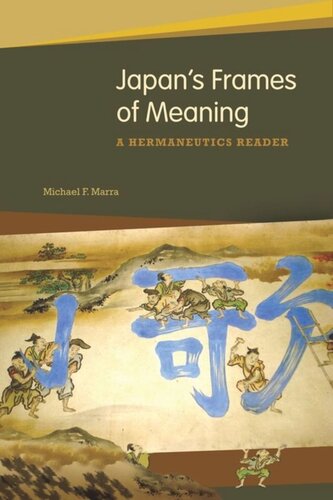

Most ebook files are in PDF format, so you can easily read them using various software such as Foxit Reader or directly on the Google Chrome browser.
Some ebook files are released by publishers in other formats such as .awz, .mobi, .epub, .fb2, etc. You may need to install specific software to read these formats on mobile/PC, such as Calibre.
Please read the tutorial at this link: https://ebookbell.com/faq
We offer FREE conversion to the popular formats you request; however, this may take some time. Therefore, right after payment, please email us, and we will try to provide the service as quickly as possible.
For some exceptional file formats or broken links (if any), please refrain from opening any disputes. Instead, email us first, and we will try to assist within a maximum of 6 hours.
EbookBell Team

4.8
84 reviewsIn Japan’s Frames of Meaning, Michael Marra identifies interpretative concepts central to discussions of hermeneutical practices in Japan and presents English translations of works on basic hermeneutics by major Japanese thinkers. Discussions of Japanese thought tend to be centered on key Western terms in light of which Japanese texts are examined; alternatively, a few Buddhist concepts are presented as counterparts of these Western terms. Marra concentrates on Japanese philosophers and thinkers who have mediated these two extremes, bringing their knowledge of Western thought to bear on philosophical reinterpretations of Buddhist terms that are, thus, presented in secularized form.
Marra focuses on categories relevant to the development of a history of Japanese hermeneutics, calling attention to concepts whose discussion sheds light on how Japanese thinkers have proceeded in making sense of their own culture. The terms are organized under three headings. The first deals with koto, which in Japanese means both "things" and "words." Koto is the center of a series of interesting compounds, such as kotodama (the spirit of words) and makoto (truth), that have shaped Japanese discourses on philosophy, ethics, aesthetics, and religion. Writings on koto by twentieth-century philosophers Watsuji Tetsuro (1889–1960) and Omori Shozo (1921–1997) and Edo-period scholar Fujitani Mitsue (1768–1823) are included. The second heading is dedicated to two well-known aesthetic categories, yugen and sabi, which point to notions of depth in physical space as well as in the space of interiority. The University of Kyoto aesthetician Ueda Juzo (1886–1973) guides the reader through a history of these concepts. In the third part of the book, notions of time in the form of ku (emptiness) and guzen (contingency) are examined through the work of Ueda’s colleagues at Kyoto, Nishitani Keiji (1900–1990) and Kuki Shuzo (1888–1941).
Perceptive and erudite, Japan’s Frames of Meaning will become a landmark resource—in particular for the insights and provocations it offers to contemporary cross-cultural philosophical dialogue—for anyone interested in traditional and modern Japanese thought.